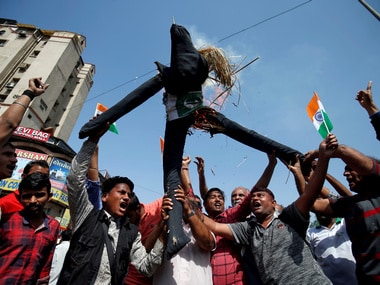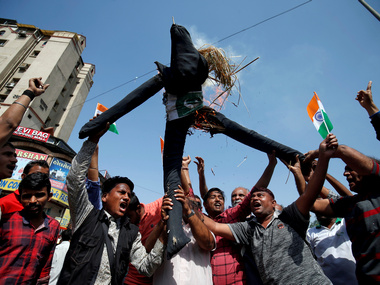The memory of India’s air strike on the militant camps in Balakot, Pakistan , will stir the emotions of Gujaratis as they queue up to cast their votes on 23 April. In their ears will echo the boast of Prime Minister Narendra Modi, who said in Jamnagar early March, “Humara siddhant hai, hum ghuske marenge [It is our principle to enter (the enemy’s) home and attack.]” It will likely inspire them to back Modi – he is, after all, Gujarat’s son, who dared Pakistan as no other Indian prime minister did previously. Expect Gujaratis to ride the tide of nationalistic fervour to the polling booth, not least because nationalism satisfies the state’s famed mercantile instinct for a homogeneously unified market. Yet, Gujarat’s nationalistic passion has been ridiculed as pseudo. This is largely because Gujaratis constitute a minuscule percentage of the Indian Army. For instance, in May 2017, Samajwadi Party leader Akhilesh Yadav taunted, “Jawans from Uttar Pradesh, Madhya Pradesh, south India and other parts of the country have sacrificed their lives, but tell me whether anyone has been martyred from Gujarat.” Yadav was roasted on social media for depicting the nationalism of Gujaratis as one of convenience, and for arguing that the community does not have to pay a price for war-mongering. But this has not deterred him from voicing his disdain for the jingoism of Gujaratis. The SP’s manifesto for the 2019 Lok Sabha election, under the chapter, ‘National Security, Not Pseudo-Nationalism’, states, “We propose to raise an Ahir Armoured Regiment and a Gujarat Infantry Regiment.” [caption id=“attachment_6494651” align=“alignleft” width=“380”]  People in Ahmedabad burn an effigy depicting Pakistan as they celebrate the Balakot air strikes in February. Reuters[/caption] The manifesto is decidedly a dig at the Gujaratis. The Ahirs or the Yadav caste, to which Akhilesh belongs, has been traditionally recruited in the Indian Army in large numbers. Steven I Wilkinson in his book, Army and Nation: The Military and Indian Democracy since Independence, provides the figures of principal ethnic groups represented in the Indian Infantry. In December 1947, the Ahirs constituted 2.8 percent of the infantry troops. In asking for an exclusive Ahir armoured regiment, Yadav is displaying the readiness of his caste to opt for the rough and dangerous life of the Army. Wilkinson’s magisterial book does not provide figures for any caste from Gujarat, which was then a part of the Bombay Presidency. However, in 2018, Devji Patel and AT Nana Patil, both Bharatiya Janata Party MPs, had asked a question in Parliament – unstarred question no. 302 – seeking information on state-wise recruitment for the Indian Army. The Ministry of Defence, on 12 December, 2018, provided the count of personnel recruited from different states between 2015 and 2018. These figures were arranged under the columns of JCO/Other Ranks. It excluded officers as state-wise data pertaining to them is not maintained. The JCO stands for Junior Commissioned Officers and includes Naib Subedar, Subedar, and Subedar Major. Other ranks comprise Sepoy, Lance Naik, Nail and Havaldar. The recruitment of Gujaratis in the army is significantly low. Between 2015 and 2018, Gujarat, including Dadra and Nagar Haveli, Daman and Diu, sent just 3,199 men to the army. By comparison, Uttar Pradesh accounted for 22,712 recruits, Uttarakhand 10,134, and Punjab 14,657. Gujarat, however, was way ahead of, say, Meghalaya, which, in the same period, sent 302 men to the army, and Tripura, which accounted for 1,370 recruits. The differences in army recruitment between states are linked to their populations. For instance, it can be said that Uttar Pradesh sends nearly seven times more men to the army than Gujarat because the former has a population three times larger than the latter. Likewise, Gujarat is nearly 20 times more populated than Meghalaya. In order to iron out the huge population differential existing among states, the two writers used the figures provided by the Ministry of Defence in 2018 to calculate the number of army recruits for every one lakh people of each state. The table (see Table I) shows Gujarat taking the 28th slot, or last but one. Between 2015 and 2018, Gujarat sent roughly 5 men for every lakh of Gujaratis. By comparison, the army recruited 11 men for every lakh of people in Uttar Pradesh, a whopping 100 men for every lakh in Uttarakhand, and 51 men for every lakh in Punjab. Himachal Pradesh topped the table with 111 men for every lakh.
| Table I: Junior Commissioned Officers Recruitment in proportion to Population |
|---|
| Sl. No. |
| 1 |
| 2 |
| 3 |
| 4 |
| 5 |
| 6 |
| 7 |
| 8 |
| 9 |
| 10 |
| 11 |
| 12 |
| 13 |
| 14 |
| 15 |
| 16 |
| 17 |
| 18 |
| 19 |
| 20 |
| 21 |
| 22 |
| 23 |
| 24 |
| 25 |
| 26 |
| 27 |
| 28 |
| 29 |
| The above date shows the recruitment of JCOs/Other Ranks State-wise data relating to recruitment of officers is not maintained. *Tripura’s GSDP values of 2015-2016 are taken The population of Dadra & Nagar Haveli and Daman & Diu is 5.86 lakhs |
There is, obviously, a historical reason why certain states, despite their small size, have a high representation in the army. In the colonial era, the British designated certain social groups as martial races. Wilkinson, who is a professor at Yale University, wrote: “The system goes back to the nineteenth century, when the British designated certain groups, such as Sikhs and Gorkhas, as ‘martial classes’ (often termed ‘martial races’) and recruited them disproportionately on the basis of their presumed martial abilities and traditions as well as their proven loyalty.” The revolt of 1857 further reinforced this tendency – the British reduced recruitment from Oudh, Bihar and the Central Provinces, from where the bulk of the military mutineers had come. They, instead, turned to the North West Frontier Provinces and Punjab for recruitment. By the 1890s, the ethnic composition of the British Indian Army had fallen into a consistent pattern – and was to remain so until India’s Independence. In the main, it consisted of, as Wilkinson writes, “a heavily Punjabi and Pashtun force from Punjab and the NWFP, with significant numbers of ‘martial class’ Gorkhas, Rajputs, Dogras, Garhwalis, Jats, and Marathas, and very little representation of anyone else.” Indeed, if Himachal Pradesh and Uttarakhand continue to send a relatively higher number of men to the army, it is because the Rajputs dominate their population. They account for nearly 33 percent of Himachal Pradesh’s population and 35 percent of Uttarakhand’s. Columnist Aakar Patel cites the British’s propensity to recruit from martial races as one of the reasons to explain Gujarat’s lack of zeal to enter the army. “There are some ‘martial’ communities in Gujarat, and these are the ones that join the army. Among them are the durbar (Rajput) communities, with names like Jadeja and Solanki.” In recent years, though, the Gujaratis have been found physically unfit for the army. From 2014, the state government initiated a campaign, “Know your Army”, to boost the recruitment, which led to a spurt. However, the numbers declined rapidly. A January 2018 report said that even those Gujaratis who were enthusiastic to join the army could not complete the 1.6-kilometre run in the qualifying time of 5.45 minutes. But Gujarat’s pathetic representation in the army is also said to be a function of its prosperity. As Wilkinson writes in Army and Nation, “The recruiting melas in Gujarat, which has a booming economy but no strong military tradition, do not yield as many recruits as those in poverty-stricken Chhattisgarh and Bihar or in the traditional recruiting areas in Punjab and Haryana.” To test Wilkinson’s proposition, we calculated the number of men that each state sends to the army per Rs 1,000 crore of Gross State Domestic Product. The table (See Table II) gets dramatically reconfigured. Himachal Pradesh and Uttarakhand retain the top two slots, but Jammu and Kashmir replaces Punjab for the third slot, from where the latter slips to number 5. Quite incredibly, Gujarat remains 28th in this table as well, confirming Wilkinson’s theory that richer states are less likely to see high military recruitment. We, obviously, don’t have tools to measure a state’s passion for nationalism. But Gujarat’s nationalistic fervour, certainly, outstrips its representation in the army. They are more an audience of war than participants, making it convenient for Gujarat to vote for nationalism.
| Table II: Junior Commissioned Officers Recruitment in proportion to GSDP |
|---|
| Sl. No. |
| 1 |
| 2 |
| 3 |
| 4 |
| 5 |
| 6 |
| 7 |
| 8 |
| 9 |
| 10 |
| 11 |
| 12 |
| 13 |
| 14 |
| 15 |
| 16 |
| 17 |
| 18 |
| 19 |
| 20 |
| 21 |
| 22 |
| 23 |
| 24 |
| 25 |
| 26 |
| 27 |
| 28 |
| 29 |
| The above date shows the recruitment of JCOs/Other Ranks State-wise data relating to recruitment of officers is not maintained. *Tripura’s GSDP values of 2015-2016 are taken The population of Dadra & Nagar Haveli and Daman & Diu is 5.86 lakhs |
Ajaz Ashraf is a journalist in Delhi. Vignesh Karthik KR is a doctoral student at King’s India Institute, King’s College London.


)

)
)
)
)
)
)
)
)



